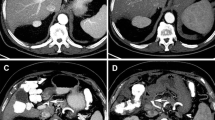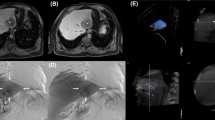Abstract
Purpose
Failing to identify aberrant hepatic arteries before radioembolization (RE) may compromise its treatment efficacy due to inadequate biodistribution of radioactive microspheres. The purpose of this study was to evaluate how often aberrant hepatic arteries were identified correctly in clinical practice, with computed tomography (CT), and during angiography in patients with liver tumors who received a workup for RE.
Methods
The presence and vascularization pattern of aberrant (i.e., accessory and replaced) hepatic arteries was assessed on triphasic liver CT in 110 patients. Subsequently, radiological reports on CT and angiographic procedures were reviewed to determine whether aberrant hepatic arteries were identified correctly in clinical practice. The intrahepatic biodistribution of 99mTc-MAA and radioactive microspheres was assessed on SPECT/CT and PET/CT in all patients with unidentified aberrant hepatic arteries.
Results
Thirty-seven of 110 patients (34 %) had aberrant hepatic arteries. In 18 of 37 (49 %) patients, the aberrant hepatic arteries were correctly identified on CT and in 32 of 37 (86 %) during angiography. Aberrant right hepatic arteries were identified more frequently than aberrant left hepatic arteries on CT (54 vs. 44 %) and during angiography (100 vs. 69 %, p = 0.007). In five patients (14 %), an aberrant left hepatic artery remained unidentified, resulting in a lack of 99mTc-MAA and 90Y activity in the segmental territory of the unidentified aberrant hepatic arteries.
Conclusions
Aberrant left hepatic arteries were the most common unidentified aberrant hepatic arteries, resulting in incomplete radiation coverage. We formulated a practical approach to identify aberrant hepatic arteries correctly before RE.






Similar content being viewed by others
References
Healey JE, Schroy PC, Sorensen RJ (1953) The intrahepatic distribution of the hepatic artery in man. J Int Coll Surg 20:133–148
Abdullah SS, Mabrut JY, Garbit V et al (2006) Anatomical variations of the hepatic artery: study of 932 cases in liver transplantation. Surg Radiol Anat 28:468–473
Gruttadauria S, Foglieni CS, Doria C, Luca A, Lauro A, Marino IR (2001) The hepatic artery in liver transplantation and surgery: vascular anomalies in 701 cases. Clin Transplant 15:359–363
Hiatt JR, Gabbay J, Busuttil RW (1994) Surgical anatomy of the hepatic arteries in 1000 cases. Ann Surg 220:50–52
Koops A, Wojciechowski B, Broering DC, Adam G, Krupski-Berdien G (2004) Anatomic variations of the hepatic arteries in 604 selective celiac and superior mesenteric angiographies. Surg Radiol Anat 26:239–244
Michels NA (1966) Newer anatomy of the liver and its variant blood supply and collateral circulation. Am J Surg 112:337–347
Lewandowski RJ, Sato KT, Atassi B et al (2007) Radioembolization with 90Y microspheres: angiographic and technical considerations. Cardiovasc Intervent Radiol 30:571–592
Smits ML, Nijsen JF, van den Bosch MA et al (2012) Holmium-166 radioembolisation in patients with unresectable, chemorefractory liver metastases (HEPAR trial): a phase 1, dose-escalation study. Lancet Oncol 13:1025–1034
Bismuth H (1982) Surgical anatomy and anatomical surgery of the liver. World J Surg 6:3–9
Elschot M, Vermolen BJ, Lam MG, de Keizer B, van den Bosch MA, de Jong HW (2013) Quantitative comparison of PET and Bremsstrahlung SPECT for imaging the in vivo yttrium-90 microsphere distribution after liver radioembolization. PLoS One 8:e55742
Smits ML, Elschot M, van den Bosch MA et al (2013) In vivo dosimetry based on SPECT and MR imaging of 166Ho-microspheres for treatment of liver malignancies. J Nucl Med 54:2093–2100
Wang S, He X, Li Z et al (2010) Characterization of the middle hepatic artery and its relevance to living donor liver transplantation. Liver Transpl 16:736–741
Abdelmaksoud MH, Louie JD, Kothary N et al (2011) Consolidation of hepatic arterial inflow by embolization of variant hepatic arteries in preparation for yttrium-90 radioembolization. J Vasc Interv Radiol 22(1364–1371):e1
Kim HC, Chung JW, An S et al (2009) Left inferior phrenic artery feeding hepatocellular carcinoma: angiographic anatomy using C-arm CT. AJR 193:W288–W294
Orth RC, Wallace MJ, Kuo MD (2008) C-arm cone-beam CT: general principles and technical considerations for use in interventional radiology. J Vasc Interv Radiol 19:814–820
Wallace MJ, Murthy R, Kamat PP et al (2007) Impact of C-arm CT on hepatic arterial interventions for hepatic malignancies. J Vasc Interv Radiol 18:1500–1507
Heusner TA, Hamami ME, Ertle J et al (2010) Angiography-based C-arm CT for the assessment of extrahepatic shunting before radioembolization. Rofo 182:603–608
Iwazawa J, Ohue S, Mitani T et al (2009) Identifying feeding arteries during TACE of hepatic tumors: comparison of C-arm CT and digital subtraction angiography. AJR 192:1057–1063
Meyer BC, Witschel M, Frericks BB et al (2009) The value of combined soft-tissue and vessel visualisation before transarterial chemoembolisation of the liver using C-arm computed tomography. Eur Radiol 19:2302–2309
Miyayama S, Yamashiro M, Hashimoto M et al (2013) Identification of small hepatocellular carcinoma and tumor-feeding branches with cone-beam CT guidance technology during transcatheter arterial chemoembolization. J Vasc Interv Radiol 24:501–508
Louie JD, Kothary N, Kuo WT et al (2009) Incorporating cone-beam CT into the treatment planning for yttrium-90 radioembolization. J Vasc Interv Radiol 20:606–613
Becker C, Waggershauser T, Tiling R et al (2011) C-arm computed tomography compared with positron emission tomography/computed tomography for treatment planning before radioembolization. Cardiovasc Intervent Radiol 34:550–556
Kothary N, Abdelmaksoud MH, Tognolini A et al (2011) Imaging guidance with C-arm CT: prospective evaluation of its impact on patient radiation exposure during transhepatic arterial chemoembolization. J Vasc Interv Radiol 22:1535–1543
Rhee TK, Omary RA, Gates V et al (2005) The effect of catheter-directed CT angiography on yttrium-90 radioembolization treatment of hepatocellular carcinoma. J Vasc Interv Radiol 16:1085–1091
Burgmans MC, Too CW, Kao YH et al (2012) Computed tomography hepatic arteriography has a hepatic falciform artery detection rate that is much higher than that of digital subtraction angiography and 99m Tc-MAA SPECT/CT: implications for planning 90Y radioembolization? Eur J Radiol 81:3979–3984
Uliel L, Royal HD, Darcy MD, Zuckerman DA, Sharma A, Saad NE (2012) From the angio suite to the gamma-camera: vascular mapping and 99m Tc-MAA hepatic perfusion imaging before liver radioembolization—a comprehensive pictorial review. J Nucl Med 53:1736–1747
Wondergem M, Smits ML, Elschot M et al (2013) 99m Tc-macroaggregated albumin poorly predicts the intrahepatic distribution of 90Y Resin microspheres in hepatic radioembolization. J Nucl Med 54:1294–1301
Conflict of interest
Andor F. van den Hoven, Maarten L.J. Smits, Bart de Keizer, Maarten S. van Leeuwen, Maurice A.A.J. van den Bosch, Marnix G.E.H. Lam have no conflict of interest.
Author information
Authors and Affiliations
Corresponding author
Rights and permissions
About this article
Cite this article
van den Hoven, A.F., Smits, M.L.J., de Keizer, B. et al. Identifying Aberrant Hepatic Arteries Prior to Intra-arterial Radioembolization. Cardiovasc Intervent Radiol 37, 1482–1493 (2014). https://doi.org/10.1007/s00270-014-0845-x
Received:
Accepted:
Published:
Issue Date:
DOI: https://doi.org/10.1007/s00270-014-0845-x




